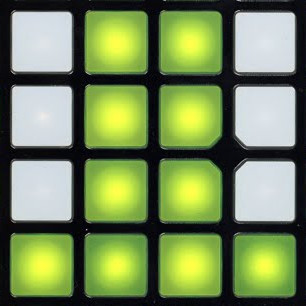256a-fall-2024/hw3
From CCRMA Wiki
Contents
Homework #3: Interactive AudioVisual Music Sequencer
NOTE: this image is here mostly for its colors, PLEASE DON'T (NECESSARILY) MAKE IT LOOK LIKE THIS!
timeline:
- HW3 milestone A (research + sketches), create hw3 webpage with 3 design sketches. (Due: 10/25 Friday 11:59PM)
- HW3 milestone B (demo/something working), be prepared to present in-class. (Due: 10/30 Wednesday 11:59PM)
- HW3 final presentation (demo/polished playable prototype), be prepared to present in-class (Due: 11/11 Monday 11:59PM)
Almost inevitably at some point in one's music software design journey, you'll be asked/tempted to make a step sequencer. In this assignment, we are going to get that off our chest/out of our system, and make a real-time, audio-visual software, driven by some kind of music sequencer!
Milestone A: Research + Preliminary Design (Due: 10/25 Friday)
- deliverables: create webpage + comment on your sequencer research + sketch 3 different designs
- do research on music sequencers!
- compile a list of useful references on various types of music sequencers / designs (articles, papers, images, etc.)
- sketch your own preliminary designs of a real-time audio-visual sequencer! make 3 different designs, maximally different from each other.
- what features to include?
- what does it look like? linear? circular? spherical? mobius?!? a game? a galaxy?? a ???
- sequencing of pitch? dynamics (loundness)? envelopes (attack/decay/sustain/release)?
- how many parallel tracks / layers / or different types of sound? (e.g., track 1 synth, track 2 drum etc)
- how do we input the sequence (in real-time)?
- how does it sound? will it use synthesis? load audio samples?
- can you save/load sequences? what file format?
- how to control/depict tempo?
- sketch as much as detail as possible, even if you don't end implementing most of them!
- hand in scans/images of your paper designs (scans/images of these design sketches can go onto your website for this project)
- ChuGL examples: https://chuck.stanford.edu/chugl/examples/sequencers/
- This project is more open-ended than the visualizers (Examples above are less like boilerplates. Please start from a blank file).
Milestone B: Something Working (Due 10/30 Wednesday)
- deliverable: update webpage, including a 1 minute video demo
- have something working in software, towards your core idea/aesthetics!
- decide on a design + set of features for a real-time audio-visual sequencer; the design decisions should account for the questions raised in part 1 above!
- using ChuGL, implement a working prototype of your music sequencer (NOTE real-time audio + graphics in the same language is where ChuGL offers its greatest advantage)
- potential things to sequence:
- pitch
- dynamics
- different timbres / instruments
- envelopes
- requirements / high-level functional aesthetic goals
- must be graphical
- must be interactive
- must be musical
- should be flexible in usability
- should support some narrative complexity
- should feel satisfying to use
- "hints"
- think of user/interaction design **and** software/system design
- create an audio engine, as well as a graphics engine; how do they interact?
- having a "grid" can be very useful (but not strictly necessary)!
Final Presentation "Playable Prototype" (Due: 11/11 Monday)
deliverables: a polished HW3 website containing:
- aim for a (semi-)polished playable prototype
- 1) a name and description of your sequencer
- 2) a few screenshots that capture your sequencer in action
- 3) a polished resolution video demo (1-3 minutes, with audio) of your sequencer, including a "mini-performance" of your musical statement
- upload to YouTube or Vimeo (or CCRMA) and embed the video from your webpage
- 4) instructions on using you sequencer
- 5) you code and all necessary assets
- 7) a final short text section that conveys:
- your ideas/inspirations in designing your sequencer
- any comments you want to share (difficulties and what you enjoyed) on this project (How did you feel as a designer?)
- system design: how is your software architected? we recommend a class diagram.
- acknowledgements for collaboration/help received(and any assets/libraries you've used)
- 8) upload the website URL to Canvas
Note
- As always, have fun with it, make the user feel something, make it satisfying.
- you are welcome to work together, but you must do your own work
- comment your code!
